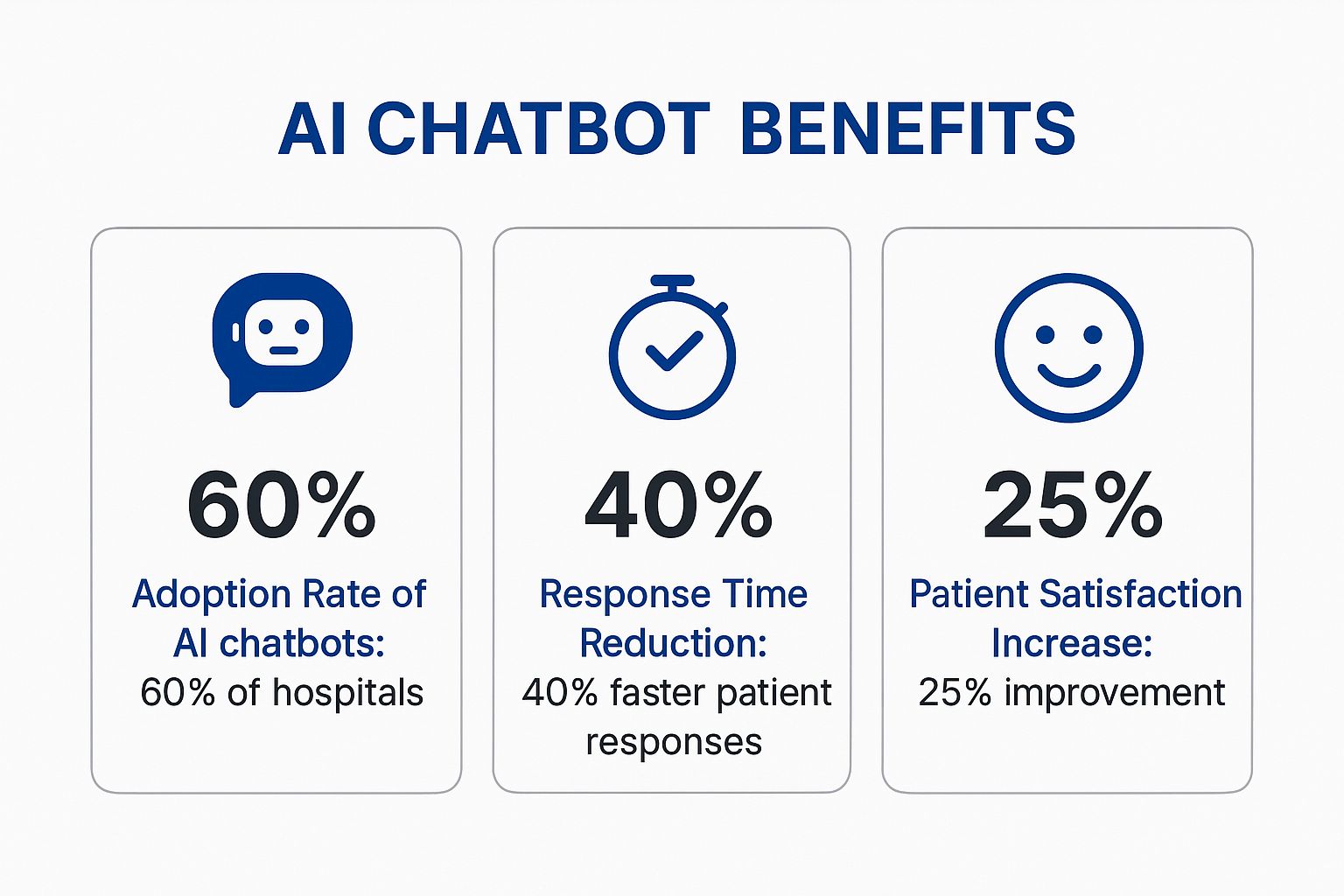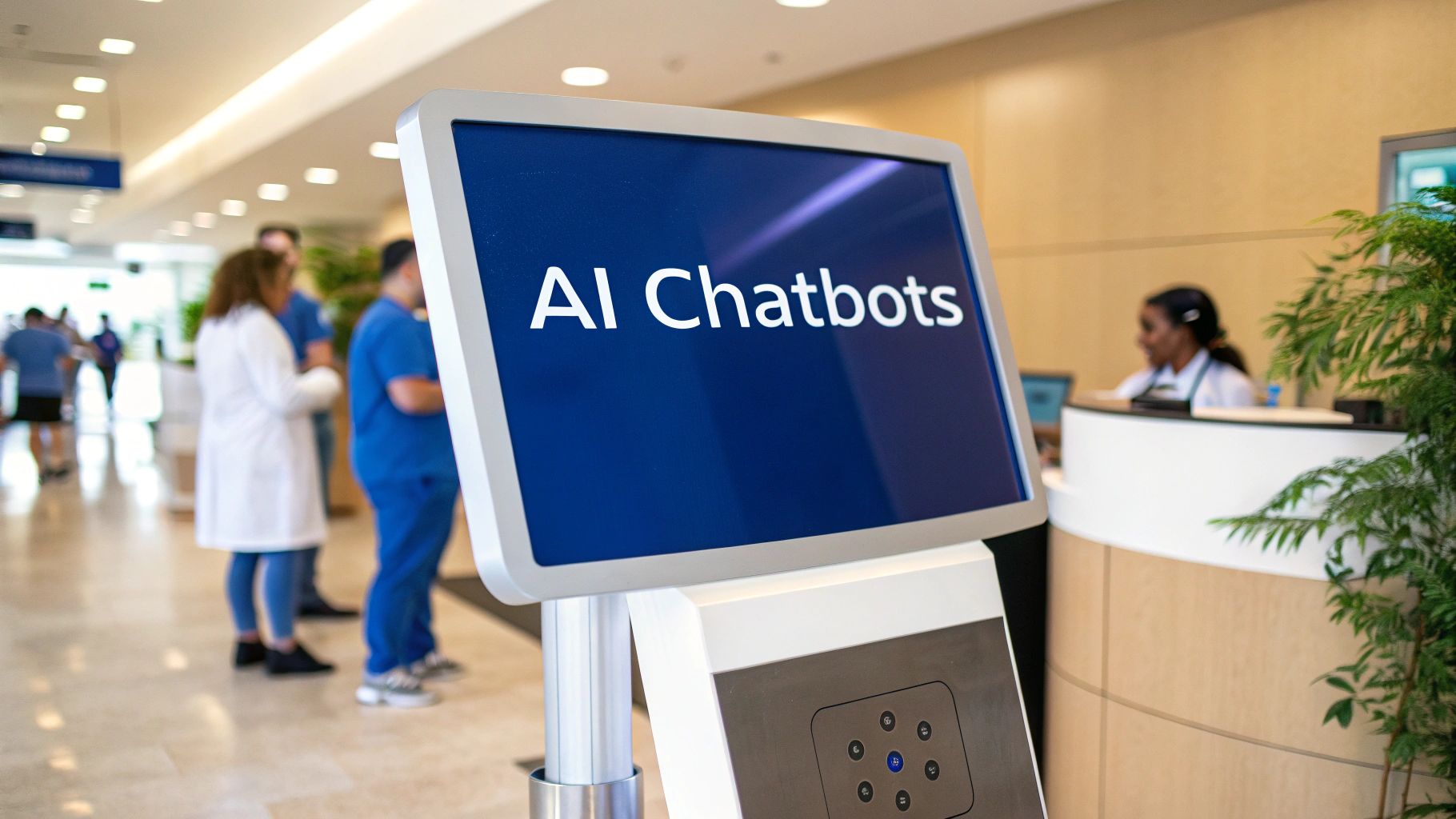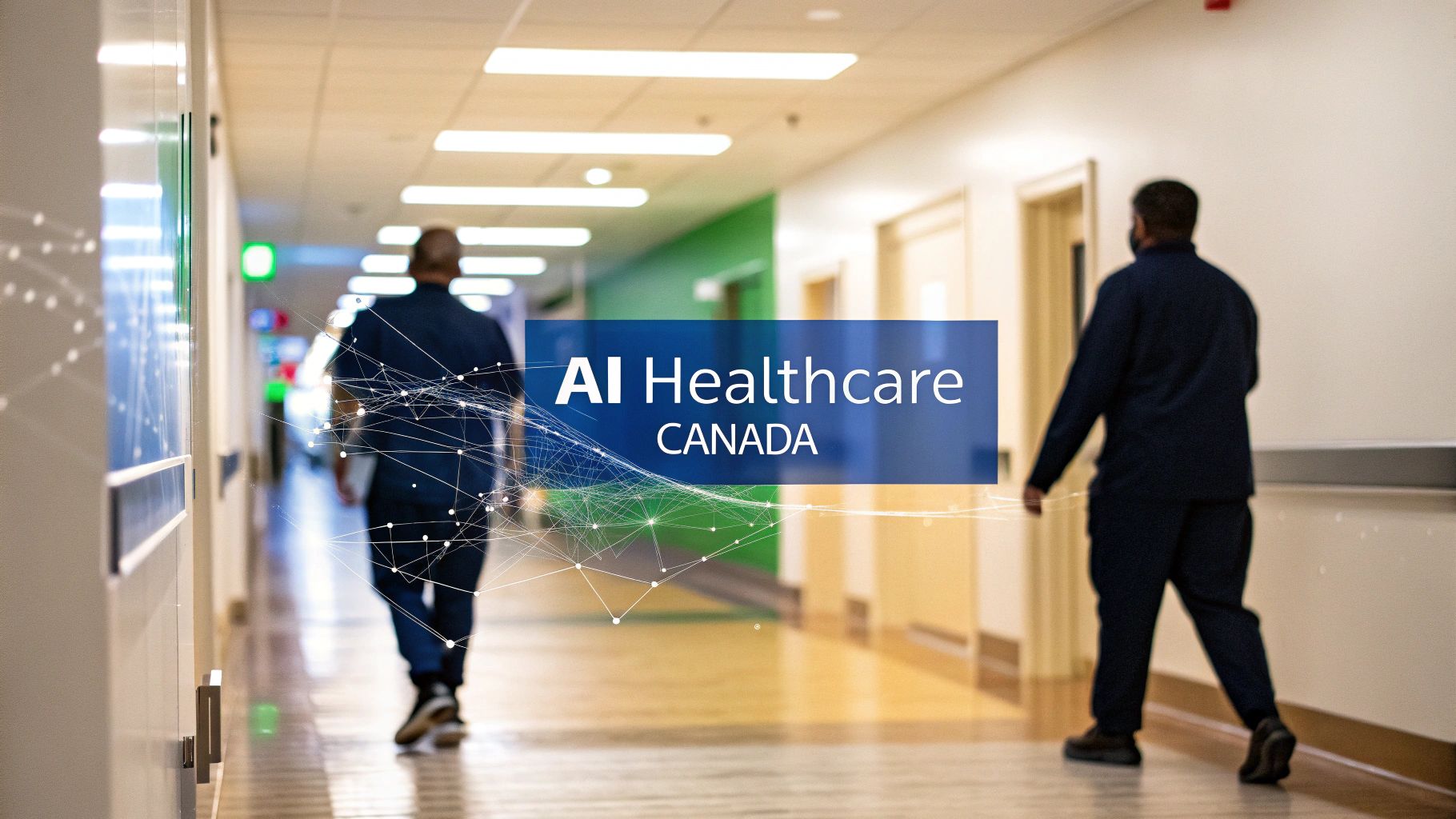Think of a medical receptionist who never sleeps, never takes a break, and can handle hundreds of patient inquiries at once. That’s essentially what AI chatbots in healthcare are: intelligent, automated assistants acting as the first point of contact for patients. They’re a direct answer to some of the most persistent headaches in the Canadian healthcare system, like frustratingly long wait times and the mountain of administrative work that bogs everything down.
The New Digital Front Door in Canadian Healthcare
The idea of a “digital front door” is completely changing how patients connect with their healthcare providers. It’s a shift away from the old model of nine-to-five phone calls and waiting on hold. Now, patients can reach out to a clinic or hospital whenever they need to, from wherever they are. AI chatbots are the gatekeepers to this new, more accessible system, offering instant help for a whole range of common needs.
This isn’t some far-off concept from a sci-fi movie; it’s a practical tool being put to work right now to manage the flow of patients and make care more accessible. In Canada, where system capacity is always a hot-button issue, these bots are quickly becoming indispensable.
Supporting Patients and Providers
For patients, the upside is obvious. A chatbot can book an appointment, offer clear answers to questions about symptoms, or send a reminder to take medication, all without a single minute spent on hold. This immediate access helps lower patient anxiety and gives people more control over their own health journey.
For providers, the relief is just as profound. By taking over routine questions and administrative chores, chatbots give precious time back to medical staff. This means nurses and receptionists can stop being switchboard operators and focus on the complex patient situations that genuinely need their expertise and a human touch. A great first step is often to bring in a virtual medical receptionist to handle these common interactions. We dig into these advantages and more in our detailed guide on the benefits of AI in Canadian healthcare.
To give you a clearer picture, here’s a quick breakdown of how these chatbots serve both sides of the healthcare equation.
Key Roles of AI Chatbots in Modern Healthcare
This table summarizes the primary functions AI chatbots perform to streamline patient and provider experiences, offering a quick snapshot of their value.
| Function | Patient Benefit | Provider Benefit |
|---|---|---|
| 24/7 Appointment Scheduling | Book, reschedule, or cancel appointments anytime, without waiting for office hours. | Reduces phone calls and frees up front-desk staff from manual booking tasks. |
| Symptom Triage | Get initial guidance on symptoms to determine if a doctor’s visit is needed. | Helps prioritize patient cases and directs non-urgent queries appropriately. |
| Medication Reminders | Receive timely alerts to take medications, improving adherence to treatment plans. | Lowers the risk of missed doses and supports better patient outcomes. |
| Answering FAQs | Instantly find answers to common questions about clinic hours, services, or insurance. | Decreases the volume of repetitive administrative inquiries for staff. |
As you can see, the value is multifaceted, creating a more efficient and responsive healthcare environment for everyone involved.
A Growing Role in the Canadian System
The move toward artificial intelligence in Canadian healthcare is picking up serious steam. According to the 2025 Watch List from the Canadian Drug Agency, AI tools like chatbots are already making a difference and are poised to dramatically improve efficiency by cutting down on administrative work. The consensus is that these tools will supplement, and in some cases, even replace certain cognitive human tasks, helping the system cope with ever-increasing demand.
AI chatbots are more than just a convenience. They are strategic assets that boost operational efficiency and, ultimately, improve the quality of patient care. By automating the repetitive stuff, they let healthcare professionals work at the top of their game, focusing on what really matters: the patient.
This guide is your roadmap to understanding how AI is fundamentally reshaping patient care across the country. We’ll explore the specific ways these tools are being used and the tangible benefits they deliver.
How Chatbots are Changing the Patient Experience

Putting aside the buzz, the real measure of AI chatbots in healthcare is how they actually improve a patient’s journey and well-being. These tools are essentially a digital front door, offering instant, reliable, and accessible support that people have come to expect in every other part of their lives. They work like a concierge, guiding patients through common administrative hurdles and answering simple health questions without the wait.
This gets right to the heart of one of the biggest frustrations in healthcare: waiting. Whether it’s being stuck on hold to book an appointment or waiting for a nurse to call back with a simple answer, these delays cause real friction and anxiety. By offering a 24/7 point of contact, chatbots give patients a sense of control over their care, letting them manage things on their own time.
The numbers back this up. The global AI chatbot market was valued at $1.2 billion in 2024 and is expected to grow dramatically, showing just how seriously organizations are taking this shift. It’s not just a nice-to-have feature anymore; it’s becoming a central piece of patient-first care.
Lightening the Load for Staff and Boosting Efficiency
One of the most immediate impacts is the automation of repetitive, time-consuming tasks. Think about any clinic or hospital in Canada, the front-desk staff spend a huge chunk of their day answering the same questions over and over: “What are your hours?”, “How do I get there?”, “Can I book a flu shot?”. This drains time that could be spent on more pressing patient issues.
When chatbots take over these routine inquiries, it frees up skilled staff to focus on patients who need a human touch, empathy, and complex problem-solving. This isn’t just a tech upgrade; it’s a smart operational move that makes AI in Healthcare so valuable. It directly helps with the intense pressure on healthcare workers, which can lead to less burnout and a better work environment.
This single change creates a positive ripple effect. When staff aren’t bogged down by administrative churn, they can provide better, more attentive care to the people right in front of them. The quality of every single interaction goes up.
By handling the high-volume, low-complexity tasks, AI chatbots enable healthcare professionals to operate at the top of their licence. This isn’t about replacing people; it’s about empowering them to do their most important work more effectively.
Improving Patient Engagement and Follow-Through
Keeping patients engaged is about more than just the time they spend in the clinic. It requires ongoing communication and support, and this is where AI chatbots truly shine. They can deliver personalized, proactive messages that keep people connected to their care plan.
Here are a few common ways chatbots are making a real difference:
- Medication Reminders: Simple, automated texts can remind a patient to take their pills on time. This small nudge can drastically improve how well people stick to their treatment, especially for those managing chronic conditions like diabetes or heart disease.
- Appointment Preparation: Chatbots can send out instructions before a visit, like fasting guidelines or forms to fill out, so patients show up ready. Afterwards, they can send a summary of the visit or check in to see if the patient has any follow-up questions.
- Personalised Education: Depending on a patient’s diagnosis, a chatbot can share helpful articles about managing their condition or videos explaining post-surgery care. This tailored information helps patients feel more informed and involved in their own health.
This kind of proactive support makes healthcare feel more personal and responsive. It closes the communication gap between appointments, making patients feel cared for throughout their entire journey. As we explored in our AI in healthcare adoption guide, building this kind of trust through consistent engagement is key.
Bringing these tools into a healthcare setting is an investment in both patient satisfaction and better long-term health. For clinics looking to build these solutions, our AI Development Services offer the expertise to create a system that fits your specific needs. Here at Cleffex, we are passionate about building these powerful tools. You can learn more on our about us page.
Real-World Applications of AI in Canadian Healthcare

It’s one thing to talk about the theory, but it’s far more interesting to see where the rubber meets the road. In Canada, AI chatbots in healthcare aren’t just a futuristic concept; they are already on the ground, delivering real, measurable results for patients and clinics alike. These tools are actively solving everyday challenges, from frustrating administrative snags to providing direct support to patients.
A fantastic example is patient triage. Picture someone feeling unwell late at night. Instead of second-guessing their symptoms until a clinic opens, they can open a chat. The bot walks them through a series of clear questions, helping to figure out if it’s a simple case of self-care, something for their family doctor, or a situation needing immediate emergency attention.
This smart screening process is a game-changer for managing patient flow. It makes sure that urgent cases get prioritised and helps cut down on unnecessary trips to the emergency room for minor issues. It’s all about getting the right resources to the right people, right when they need them.
Streamlining Appointments and Reminders
Let’s be honest, managing clinic appointments can be a headache. The endless phone calls for scheduling, rescheduling, and cancelling eat up a huge amount of staff time. This is where AI chatbots truly shine by automating the whole process into a 24/7 self-serve portal.
Patients can see available slots, book a time that suits them, and get an instant confirmation without ever needing to speak to a receptionist. This level of convenience is a massive improvement to the patient experience. What’s more, these bots send out automated reminders: a simple but incredibly effective way to reduce no-show rates, which can be a serious drain on a clinic’s finances and resources.
This kind of automation is a central benefit of AI chatbot integration services. It transforms a tedious manual task into a smooth, hands-off workflow.
Enhancing Medication Adherence
Getting patients to stick to their prescribed medication is one of the oldest challenges in healthcare, especially for those managing chronic conditions. Even one missed dose can set back their progress and drive up healthcare costs. Here, AI chatbots step in as a personal medication assistant.
They can be set up to send timely reminders for every dose, offer information on side effects, and even answer quick questions about drug interactions. This steady, non-judgmental support helps people stay on track with their treatment plans, giving them more control over their own health right from home. It’s a perfect example of how AI in Healthcare can fill the gaps between clinic appointments.
By providing proactive support and personalized reminders, AI chatbots don’t just dispense information, they actively participate in the patient’s care journey, encouraging better habits and improving long-term health outcomes.
The results speak for themselves. Across the healthcare sector, approximately 59% of providers are already using AI-powered virtual assistants for jobs like scheduling and triage. And they’re efficient, too, resolving 67% of patient inquiries in under 10 minutes. In remote care situations, AI assistants have boosted patient follow-up adherence by 24%. Hospitals using them have even seen a 38% drop in nurse call centre volume, freeing up highly skilled staff for more critical work.
Providing Accessible Mental Health Support
In Canada, the demand for mental health services often far exceeds the available supply, creating long and frustrating waitlists. AI chatbots are stepping up as a valuable first line of support, offering a confidential, judgment-free space for people to talk about what they’re going through.
These bots can guide users through practical techniques like cognitive behavioural therapy (CBT) exercises, lead mindfulness practices, and suggest coping strategies for stress or anxiety. While they’ll never replace a human therapist, they are an incredibly important and accessible resource for individuals who might be hesitant to seek help or are stuck waiting for an appointment.
The numbers are telling: 76% of mental health platforms now incorporate conversational AI to deliver guided therapies. For any organisation looking to build these kinds of powerful tools, comprehensive AI development Services offer the expertise needed to create effective and compliant solutions. As we’ve covered in our AI in healthcare adoption guide, applying this technology responsibly is absolutely key. Our team is passionate about building these solutions. You can learn more about us and see our commitment firsthand.
Navigating Canadian Healthcare Regulations and Ethics
Bringing AI chatbots into the Canadian healthcare system is about so much more than just the technology. It means carefully picking your way through a complex web of regulations and ethical duties, all designed to protect patients. Getting this right isn’t just a box to tick; it’s the very foundation of a trustworthy and successful rollout.
The biggest hurdle is often Canada’s unique mix of privacy laws. Federally, you have the Personal Information Protection and Electronic Documents Act (PIPEDA), which sets the ground rules. But because healthcare is a provincial matter, you also need to follow very specific and often stricter laws like Ontario’s Personal Health Information Protection Act (PHIPA) and its counterparts across the country.
These laws dictate exactly how personal health information can be collected, used, and shared. Since an AI chatbot is built to handle this exact kind of sensitive data, absolute compliance is non-negotiable.
Upholding Data Security and Privacy
Protecting patient data is, without a doubt, the most important job. A data breach in healthcare isn’t just a corporate headache; it exposes deeply personal information, erodes public trust, and can cause real harm to individuals.
To meet this incredibly high bar, healthcare organizations must bake in several key security measures from the very beginning:
- End-to-End Encryption: All data, whether it’s in transit or sitting on a server, has to be fully encrypted to keep it away from prying eyes.
- Secure Data Storage: Patient information must be stored on servers that meet Canadian data residency laws, which often means the data has to physically stay within Canada’s borders.
- Strict Access Controls: Only authorized staff should ever be able to see patient data, and you need tight protocols to track and audit every single view.
Building these protections into the system’s DNA is the only way to deploy these tools responsibly.
Addressing Algorithmic Bias and Ensuring Fairness
Beyond security lies the equally tricky world of ethics, and algorithmic bias is a massive concern. AI models are only as good as the data they learn from. If that data carries the baggage of existing societal or medical biases, the AI will not only learn them, but it can make them worse.
Think about it: an AI trained mostly on data from one demographic might give less accurate advice to people from other backgrounds. This isn’t just a technical glitch; it can create serious health inequities. The only way to fight this is to use diverse, representative datasets for training and to constantly check the algorithms for any signs of unfair outcomes. We take a much deeper look at this in our post on the ethics of AI in healthcare.
When you get the compliance and ethics right, the results speak for themselves.

This data shows a clear picture: when built on a foundation of trust, chatbots can genuinely improve both efficiency and the patient experience.
The Human-in-the-Loop Imperative
For all their power, chatbots can’t replace the nuanced judgment of a healthcare professional. This is where the “human-in-the-loop” model becomes absolutely essential. When it comes to any meaningful clinical decision, a human expert must be involved.
A chatbot can help triage symptoms or provide useful information, but it should never be the one making a final diagnosis. Its job is to support clinicians, not to replace them.
Canada’s regulatory framework for AI is still taking shape. For now, provincial governments are leaning on existing laws to manage the safety and ethical questions that come with these new tools. This reality just reinforces the need for a careful, measured, and well-planned approach to implementation.
Before diving in, it’s crucial to map out these considerations. This table serves as a starting point for any healthcare organization in Canada looking to adopt AI chatbot technology.
Key Implementation Considerations for Healthcare AI Chatbots
| Consideration Area | Key Action/Question | Importance |
|---|---|---|
| Regulatory Compliance | Have we audited our plan against both federal (PIPEDA) and provincial (e.g., PHIPA) health privacy laws? | Critical |
| Data Residency | Where will patient data be stored? Does it comply with Canadian data residency requirements? | Critical |
| Data Security | Is end-to-end encryption implemented for all data, both in transit and at rest? | High |
| Algorithmic Bias | Was the AI model trained on a diverse and representative dataset to avoid demographic bias? | High |
| Clinical Oversight | Is there a clear “human-in-the-loop” protocol for any clinical recommendations or high-stakes interactions? | Critical |
| Transparency | Are patients clearly informed that they are interacting with an AI and aware of its limitations? | High |
Taking the time to address each of these points is not just about avoiding legal trouble; it’s about building a solution that patients and providers can actually trust. Building that trust starts with being completely transparent about how the AI works and what it can’t do. By thoughtfully navigating these requirements, you can build tools that are not only innovative but also genuinely safe and effective.
Your Step-by-Step Implementation Roadmap

Successfully bringing an AI chatbot into your healthcare practice isn’t about flipping a switch and hoping for the best. It takes a thoughtful, structured plan. This is how you build a solution that genuinely helps patients and staff, earning their trust along the way. Without a clear roadmap, you risk adding another layer of complexity instead of a valuable asset.
The whole process starts with one simple question: what problem are we actually trying to solve? Vague goals like “improving efficiency” just won’t cut it. You need to define clear, measurable objectives that will steer every decision you make from here on out.
Think of this initial phase as the foundation of your entire project. If you don’t know what success looks like, you’ll never be able to measure it or justify the investment.
Phase 1: Define Your Goals and Scope
Before you even look at technology, you have to pinpoint the exact pain points you want the chatbot to fix. A well-defined objective is what separates a successful project from a costly experiment. The key is to start with a specific, high-impact area where automation can make a real, tangible difference.
Not sure where to begin? Consider these common starting points:
- Reduce Administrative Load: Aim to cut down on inbound calls for appointment scheduling by 30% within the first six months.
- Lower No-Show Rates: Target a 15% drop in missed appointments by using automated reminders and offering easy rescheduling options.
- Improve Patient Access to Information: Ensure 90% of common questions (like clinic hours, parking, or preparation for a procedure) get an instant, accurate answer 24/7.
Once you have a primary goal, it’s time to define the scope. Will the chatbot only handle scheduling, or will it also send out medication reminders? A focused, phased approach is almost always the smarter path. Trying to build an all-in-one solution right out of the gate is a recipe for frustration.
Phase 2: Select the Right Technology Partner
Choosing who will help you build your chatbot is a critical decision. You’re not just looking for a software vendor; you need a partner with deep experience in the healthcare space. They must understand the strict compliance and security demands that come with handling patient data in Canada.
Your technology partner isn’t just a coder; they’re your guide through the technical maze of AI and the regulatory landscape of healthcare. Their ability to deliver a secure, compliant, and effective solution is the single most important factor for success.
When you’re vetting potential partners, ask them the tough questions.
- How much experience do you have with Canadian healthcare privacy laws like PHIPA?
- How do you guarantee that our data is encrypted and stored according to data residency rules?
- Can you show us case studies from similar healthcare chatbot projects you’ve completed?
- What’s your process for integrating the chatbot with our existing Electronic Health Record (EHR) system?
This is where having an expert on your side makes all the difference.
Phase 3: Plan for Integration and Training
A chatbot can’t operate in a silo. For it to be truly useful, it needs to connect seamlessly with the systems you already use, especially your EHR. This integration is what allows the chatbot to check real-time appointment availability and securely update patient records without manual intervention.
This technical planning has to happen in tandem with staff training. Your team needs to understand what the chatbot can do, and just as importantly, what it can’t do. They should see it as a helpful tool that frees them up for more complex tasks, not as a threat to their jobs. Proper training will help turn your staff into champions for the new technology.
If you need a framework for this, our guide on creating a technology roadmap template is a great place to start.
Phase 4: Test Rigorously and Launch Strategically
Before a single patient interacts with your chatbot, it needs to be put through its paces. This means rigorous internal testing, often called User Acceptance Testing (UAT). Have your own staff act like patients to find any bugs, awkward phrasing, or confusing conversation flows. The goal is to polish the experience until it feels helpful, intuitive, and even empathetic.
From there, consider a pilot launch with a small, select group of patients. This is your chance to gather real-world feedback and make final tweaks before the full rollout. This step-by-step approach ensures that when your chatbot goes live for everyone, it delivers immediate value and makes a great first impression.
The Future of Conversational AI in Medicine
We’re only scratching the surface of what AI chatbots can do in healthcare. The technology is quickly moving beyond administrative tasks and evolving into a true clinical partner, woven directly into the daily fabric of patient care. This isn’t about replacing doctors and nurses; it’s about creating a powerful partnership between human expertise and artificial intelligence.
One of the biggest changes coming is the shift to voice and “ambient” interactions. Picture a doctor having a normal conversation with a patient. In the background, an AI assistant listens in, transcribes everything, and updates the electronic health record on the fly. This kind of hands-free interaction will lift a huge documentation burden, freeing up clinicians to focus completely on the person in front of them.
Hyper-Personalization and Proactive Care
The next wave of chatbots will offer incredibly personalized support. By securely tapping into a patient’s health records, data from wearable devices, and maybe even genetic information, these tools can provide advice that’s built for one person and one person only. This is so much more than just sending a generic reminder.
The future of AI in medicine is proactive, not reactive. Chatbots will evolve into wellness coaches that can anticipate a patient’s needs, identify potential health risks based on daily data, and provide gentle nudges toward healthier habits before problems arise.
This kind of deep personalization will make healthcare feel more connected and continuous, extending care well beyond the four walls of a clinic. For example, a chatbot could see a spike in a diabetic patient’s glucose readings from their monitor and immediately suggest a specific meal or activity to help stabilize it.
Advancements in Diagnostic and Clinical Support
Further down the road, these AI assistants will become indispensable diagnostic aids. They won’t replace a clinician’s judgment, but they will be able to analyze symptoms, patient history, and vast amounts of medical literature to suggest possible diagnoses or flag subtle patterns a human might overlook. Think of it as a highly intelligent second opinion, designed to enhance a doctor’s own skills and improve accuracy.
To really get this right, it’s crucial to understand the principles behind Chat AI technology.
As we’ve discussed before, the ethical side of implementing these advanced tools is everything. The ultimate goal is a healthcare system where technology manages the data, freeing up humans to focus on what they do best: providing empathy, critical thinking, and genuine human connection.
Frequently Asked Questions
It’s natural to have questions when considering new technology like AI chatbots in healthcare. We’ve gathered some of the most common ones we hear from Canadian healthcare providers to give you the clear, straightforward answers you need.
How is Patient Data Kept Private and Secure?
Patient confidentiality is non-negotiable. Any chatbot used in a Canadian healthcare setting must operate in strict compliance with federal PIPEDA and provincial laws like Ontario’s PHIPA.
This means using robust, end-to-end encryption for every single interaction. It also means guaranteeing that all patient data is stored on secure, Canada-based servers, a critical step to meet our country’s data residency laws.
Will AI Chatbots Replace Doctors and Nurses?
Not at all. Think of an AI chatbot as a highly efficient assistant, not a replacement for a clinician. Their real value lies in automating repetitive, high-volume tasks that consume valuable staff time.
They can handle things like appointment scheduling, sending reminders, and answering basic questions. This frees up your doctors and nurses to dedicate their expertise to what truly matters: direct, complex patient care that demands human empathy and clinical judgment.
What is the First Step My Clinic Should Take to Get Started?
The best way to begin is to start small and specific. Don’t try to solve every problem at once. Instead, identify a single, significant pain point in your daily operations.
Maybe you’re swamped with phone calls for appointment bookings, or perhaps your patient no-show rate is a constant challenge. Pinpoint that one issue and launch a focused pilot project to solve it. This approach lets you measure the chatbot’s impact clearly and prove its value before you consider expanding its duties.
What Does a Healthcare Chatbot Implementation Cost?
The cost really depends on what you need it to do. A straightforward chatbot that answers common questions from a pre-written script will naturally be less of an investment than a custom-built system that integrates deeply with your Electronic Health Record (EHR).
Pricing models vary, too; some are monthly subscriptions, while others are one-time development fees. It’s all about finding a solution that aligns with your clinic’s budget and specific goals. Working with the right AI Development Services helps you sort through these options. As we explored in our AI in healthcare adoption guide, a thoughtful approach is key. You can learn more about our team’s expertise on our about us page.
Ready to explore how AI can elevate your healthcare practice? At Cleffex Digital Ltd, we specialize in building secure, compliant, and effective AI solutions designed for the unique needs of the Canadian healthcare sector.








